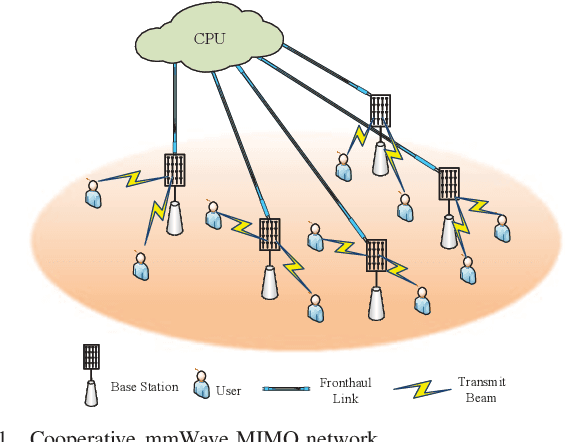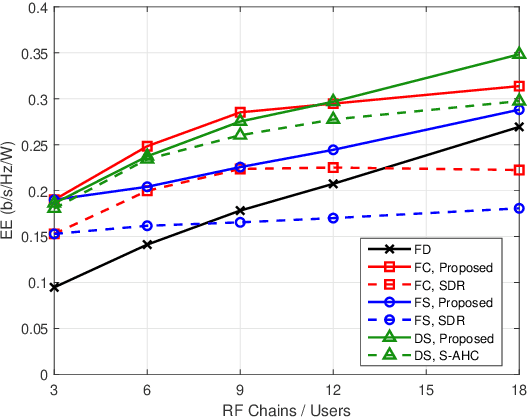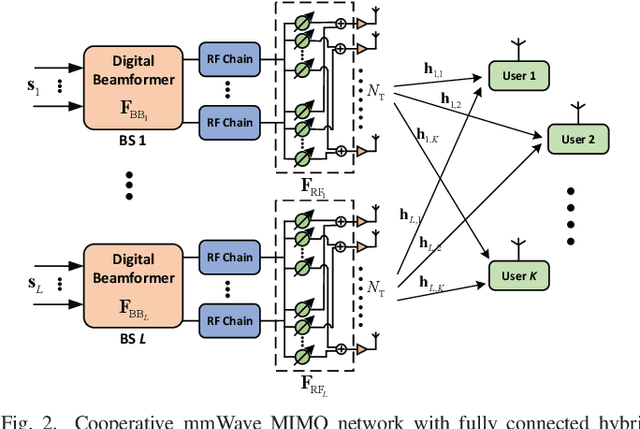Pengfei Ni
User Association and Hybrid Beamforming Designs for Cooperative mmWave MIMO Systems
Aug 10, 2022



Abstract:Hybrid analog and digital beamforming has emerged as a key enabling technology for millimeter wave (mmWave) massive multiple-input multiple-output (MIMO) communication systems since it can balance the trade-off between system performance and hardware efficiency. Owing to the strong ability of central control, cooperative networks show great potential to enhance the spectral efficiency of mmWave communications. In this paper, we consider cooperative mmWave MIMO systems and propose user association and hybrid beamforming design algorithms for three typical hybrid beamforming architectures. The central processing unit (CPU) of the cooperative networks first matches the service pairs of base stations (BSs) and users. Then, an iterative hybrid beamforming design algorithm is proposed to maximize the weighted achievable sum-rate performance of the mmWave MIMO system with fully connected hybrid beamforming architecture. Moreover, a heuristic analog beamforming design algorithm is introduced for the fixed subarray hybrid beamforming architecture. In an effort to further exploit multiple-antenna diversities, we also consider the dynamic subarray architecture and propose a novel antenna design algorithm for the analog beamforming design. Simulation results illustrate that the proposed hybrid beamforming algorithms achieve a significant performance improvement than other existing approaches and the dynamic subarray architecture has great advantages of improving the energy efficiency (EE) performance.
* 14 pages, 10 figures, accepted by TSIPN
Partially Distributed Beamforming Design for RIS-Aided Cell-Free Networks
Aug 10, 2022


Abstract:Cell-free networks are regarded as a promising technology to meet higher rate requirements for beyond fifth-generation (5G) communications. Most works on cell-free networks focus on either fully centralized beamforming to maximally enhance system performance, or fully distributed beamforming to avoid extensive channel state information (CSI) exchange among access points (APs). In order to achieve both network capacity improvement and CSI exchange reduction, we propose a partially distributed beamforming design algorithm for reconfigurable intelligent surface (RIS)-aided cell-free networks. We aim at maximizing the weighted sum-rate of all users by designing active and passive beamforming subject to transmit power constraints of APs and unit-modulus constraints of RIS elements. The weighted sum-rate maximization problem is first transformed into an equivalent weighted sum-mean-square-error (sum-MSE) minimization problem, and then alternating optimization (AO) approach is adopted to iteratively design active and passive beamformer. Specifically, active beamforming vectors are obtained by local APs and passive beamforming vector is optimized by central processing unit (CPU). Numerical results not only illustrate the proposed partially distributed algorithm achieves the remarkable performance improvement compared with conventional local beamforming methods, but also further show the considerable potential of deploying RIS in cell-free networks.
BS-RIS-User Association and Beamforming Designs for RIS-aided Cellular Networks
Jun 27, 2021



Abstract:Reconfigurable intelligent surface (RIS) has been regarded as a revolutionary and promising technology owing to its powerful feature of adaptively shaping wireless propagation environment. However, as a frequency-selective device, the RIS can only effectively provide tunable phase-shifts for signals within a certain frequency band. Thus, base-station (BS)-RIS-user association is an important issue to maximize the efficiency and ability of the RIS in cellular networks. In this paper, we consider a RIS-aided cellular network and aim to maximize the sum-rate of downlink transmissions by designing BS-RIS-user association as well as the active and passive beamforming of BSs and RIS, respectively. A dynamically successive access algorithm is developed to design the user association. During the dynamical access process, an iterative algorithm is proposed to alternatively obtain the active and passive beamforming. Finally, the optimal BS-RIS association is obtained by an exhaustive search method. Simulation results illustrate the significant performance improvement of the proposed BS-RIS-user association and beamforming design algorithm.
 Add to Chrome
Add to Chrome Add to Firefox
Add to Firefox Add to Edge
Add to Edge